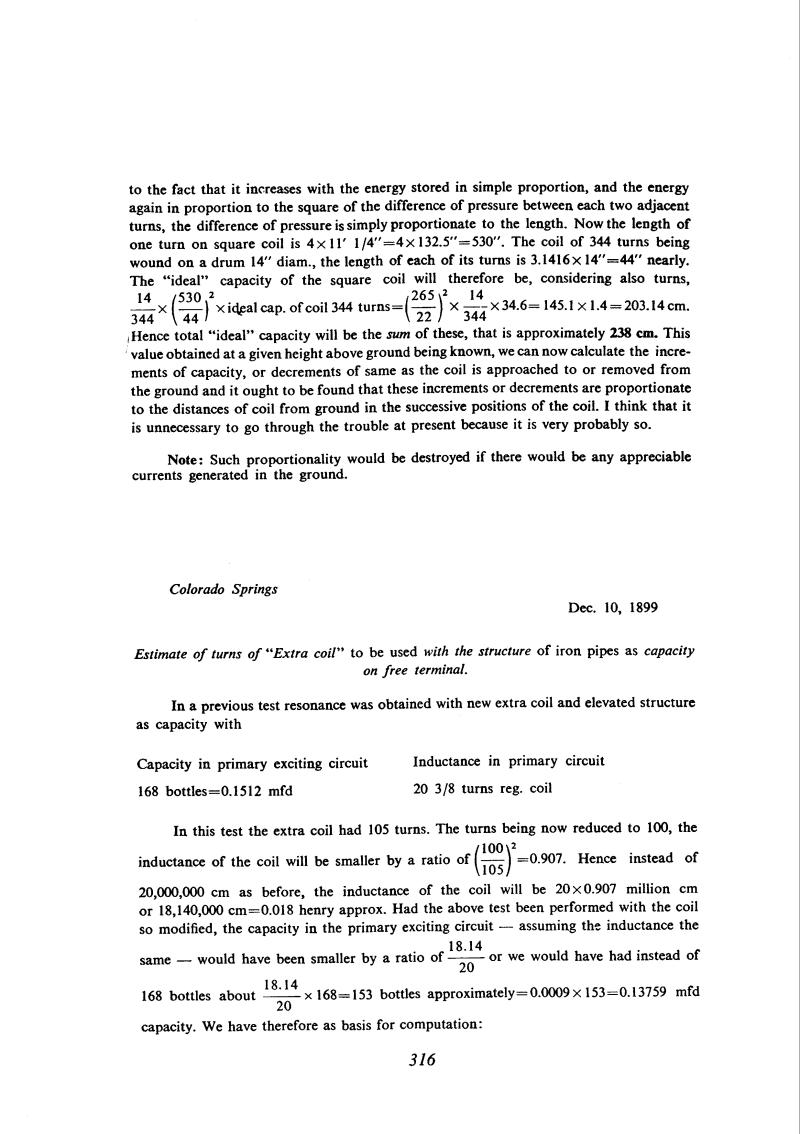
Nikola Tesla Books
to the fact that it increases with the energy stored in simple proportion, and the energy again in proportion to the square of the difference of pressure between each two adjacent turns, the difference of pressure is simply proportionate to the length. Now the length of one turn on square coil is 4x11' 1/4" = 4 x 132.5" = 530". The coil of 344 turns being wound on a drum 14" diam., the length of each of its turns is 3.1416 x 14" = 44" nearly. The âidealâ capacity of the square coil will therefore be, considering also turns, $! {14 \over 344} $! x $! {\left({530 \over 44}\right)^{2}} $! x ideal cap. of coil 344 turns = $! {\left({265 \over 22}\right)^{2}} $! x $! {14 \over 344} $! x 34.6 = 145.1 x 14 = 203.14 cm. Hence total âidealâ capacity will be the sum of these, that is approximately 238 cm. This value obtained at a given height above ground being known, we can now calculate the increments of capacity, or decrements of same as the coil is approached to or removed from the ground and it ought to be found that these increments or decrements are proportionate to the distances of coil from ground in the successive positions of the coil. I think that it is unnecessary to go through the trouble at present because it is very probably so.
Note: Such proportionality would be destroyed if there would be any appreciable currents generated in the ground.
Colorado Springs
Dec. 10, 1899
Estimate of turns of âExtra coilâ to be used with the structure of iron pipes as capacity on free terminal.
In a previous test resonance was obtained with new extra coil and elevated structure as capacity with
| Capacity in primary exciting circuit | Inductance in primary circuit |
| 168 bottles = 0.1512 mfd | 20 3/8 turns reg. coil |
In this test the extra coil had 105 turns. The turns being now reduced to 100, the inductance of the coil will be smaller by a ratio of $! {\left({100 \over 150}\right)^{2}} $! = 0.907. Hence instead of 20,000,000 cm as before, the inductance of the coil will be 20 x 0.907 million cm or 18,140,000 cm = 0.018 henry approx. Had the above test been performed with the coil so modified, the capacity in the primary exciting circuit - assuming the inductance the same - would have been smaller by a ratio of $! {18.14 \over 20} $! or we would have had instead of 168 bottles about $! {18.14 \over 20} $! x 168 = 153 bottles approximately = 0.0009 x 153 = 0.13759 mfd capacity. We have therefore as basis for computation:
316

